Toque macaque
The toque macaque (Macaca sinica) is a reddish-brown-coloured Old World monkey endemic to Sri Lanka, where it is known as the rilewa or rilawa (Sinhala: රිළවා), (hence "rillow" in the Oxford English Dictionary).
| Toque macaque[1] | |
|---|---|
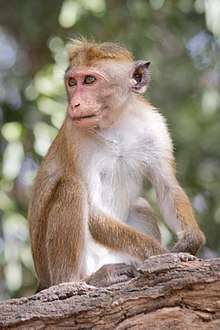 | |
| Scientific classification | |
| Kingdom: | Animalia |
| Phylum: | Chordata |
| Class: | Mammalia |
| Order: | Primates |
| Suborder: | Haplorhini |
| Infraorder: | Simiiformes |
| Family: | Cercopithecidae |
| Genus: | Macaca |
| Species: | M. sinica |
| Binomial name | |
| Macaca sinica (Linnaeus, 1771) | |
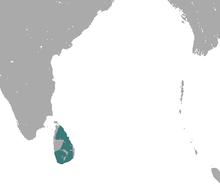 | |
| Toque macaque range | |
Description
With age, the face of females turns slightly pink. This is especially prominent in the subspecies sinica.
Distribution
M. s. sinica is found from the Vavuniya, [[Mannar District|Mannar] to the lowlands of Anuradhapura, Polonnaruwa, Puttalam, and Kurunegala; and along the arid zone of the Monaragala and Hambantota districts.
M. s. aurifrons can be found sympatrically with subsp. sinica within intermediate regions of the country in Kegalle and parts of Kurunegala. They are also found in south-western parts of the island in the Galle and Matara districts near Kalu Ganga.
M. s. opisthomelas has recently been identified as a separate subspecies. It can be found in the entire south-western region of central hill bordering Ratnapura) and in the Nuwara Eliya districts. They can be seen around the Hakgala Botanical Garden and other cold climatic montane forest patches.[3] They also can be observed in Trincomalee near Koneswaram Temple.[4]
Taxonomy
The three recognized subspecies of toque macaques are:
- Dryzone toque macaque or Common toque macaque = Macaca sinica sinica
- Wetzone toque macaque or Pale-fronted toque macaque = Macaca sinica aurifrons
- Highland toque macaque or Hill-zone toque macaque = Macaca sinica opisthomelas
M. s. opisthomelas is similar to subsp. aurifrons, but has a long fur and contrasting golden color in the anterior part of its brown cap.
The three subspecies can be identified through the orientation of their different hair patterns.
Social structure
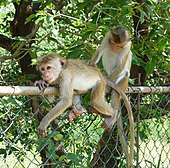
The social status is highly structured in toque macaques, where there are dominance hierarchies among both males and females. A troop may consist of as few as 8 to as many as 40. When the troop becomes too large, social tension and aggression towards each other arise, causing some individuals to flee from the troop. This is noticeable in adults and sub adults, where a troop may consist largely of females. Newly appointed alpha males also show aggressiveness towards females, causing the females to flee. There are sightings of severe fights between individuals of the same troop and some get heavy wounds to cheeks, eyes, and sometimes broken arms.[3]
Young offspring of a troop's alpha female will typically receive better sustenance and shelter than their peers.[5]
Reproduction
.jpg)
When in estrous, the female's perineum becomes reddish in color and swells. This change is a signal to the males that she is ready to mate. There is an average of 18 month between births. After a 5–6 month gestation period, female macaque give birth to a single offspring. Offspring hold on to their mothers for about 2 months. During this time they learn survival techniques and social skills critical for survival. The infants are born into their social classes based on their mothers position in the troop. Young males are forced to abandon their troop when they are about 6–8 years of age. This prevents in-breeding and ensures that the current alpha male maintains his position in the troop. Leaving the troop is the only way a male can change his social standing. If he has good social skills and is strong he may become an alpha male. A single alpha male can father all of the troops' offspring.[3]
Birth rarely occurs during the day or on the ground. During labor the female isolates herself from the group (about 100 m). The mother stands bipedally during parturition and assists the delivery with her hands. The infant is usually born 2 minutes after crowning. The infant can vocalize almost immediately after birth; it is important for the mother and infant to recognize each other's voices. Vocalization will be used to alert the mother of imminent danger, and can assist in finding each other if separated. After birth the mother licks the infant and orients it toward her breasts. She will resume foraging behavior within 20 minutes after parturition. The mother also eats part of the placenta, because it contains needed protein. The alpha female of the group asserts her power by taking part of the placenta for herself to eat.[6]
Diet
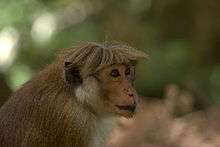
They are fond of eating drooping yellow clusters of flowers of Cassia fistula. They eat any good thing making use of human detritus by going after plantains, pineapples, rice grains, papaws, and mangoes. Even there are plenty of foods present in natural habitation, toque macaques enjoy to take any food with little effort around human dwellings. They are occasionally seen around houses near a forest patch, where they invade all the fruiting plants in the day sessions and return to the forest cover in night. Because, these macaques have very little fear for humans and their companions-the dogs.
Cheek pouches enable toque macaques to store enough food while eating fast. In the dry zone, they are known to eat drupes of understory shrub Zizyphus, ripe fruits of Ficus, and Cordia species. They occasionally eat many small animals ranging from small insects to mammals like indian palm squirrels and Vandeleuria oleracea.[3]
Predators
Wild cats (leopards and fishing cats) and Indian rock python are the main predators of this species.
Life expectancy
The lifespan of toque macaques in the wild is about the same as in captivity, up to 35 years. The expected lifespan in the wild is low due to high infant mortality rates. There is also significant mortality among adolescent males when they venture off to join a different troop. Once toque macaques have reached sexual maturity they will likely live to an old age. (Fooden, 1979; Michael and Crook, 1973).[7]
Conservation
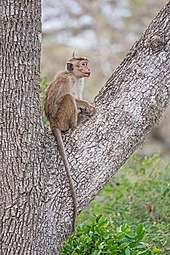
As of 2008, IUCN listed toque macaque as endangered in their list due to habitat destruction and hunting, and also for taming for pets.[8] With few patches of forests for survival, they engage to survive close to human habitation, giving a serious trouble for both the parties. Due to devastated eating of crop plants, humans always take precautions to avoid their entrance to the cultivation fields. This results killing by shot, trappings, and poisoning.
Both subsp. aurifrons and sinica are kept as pets by various indigenous people for economic purposes. They were heavily used by both Sri Lanka Army and LTTE for their shooting practices in the recent past, but now prohibited.[2]
Antibody prevalence
In an experiment, serum samples taken from toque macaque individuals at Polonnaruwa were examined for antibodies to Toxoplasma gondii by the modified agglutination test. There was no evidence of maternal transmission of antibodies or congenital toxoplasmosis. None of the infected macaques died within 1 year after sampling. Toxoplasma gondii infection was closely linked to human environments where domestic cats were common. Although infection with T. gondii has been noted in several species of Asian primates, this is the first report of T. gondii antibodies in toque macaques.
As dengue reservoir
It's unclear if nonhuman primates also serve as a reservoir of human dengue viruses under certain conditions. According to a study by some biologists, a cross-sectional serologic survey was carried out to characterize the pattern of transmission of a recently identified dengue virus among toque macaques in Sri Lanka. The results indicated that an epizootic dengue virus was active among the macaques. A single epizootic had taken place between October 1986 and February 1987 during which 94% of the macaques within the 3 km2 study site were exposed to the virus. The epizootic was highly focal in nature because macaques living 5 km from the study population were not exposed to the virus. The transmission of dengue viruses among macaques in the wild may have important public health implications.[9]
References
- Groves, C. P. (2005). Wilson, D. E.; Reeder, D. M. (eds.). Mammal Species of the World: A Taxonomic and Geographic Reference (3rd ed.). Baltimore: Johns Hopkins University Press. p. 164. ISBN 0-801-88221-4. OCLC 62265494.
- Dittus, W.; Watson, A. & Molur, S. (2008). "Macaca sinica". IUCN Red List of Threatened Species. 2008: e.T12560A3358720. doi:10.2305/IUCN.UK.2008.RLTS.T12560A3358720.en.
- Yapa, A.; Ratnavira, G. (2013). Mammals of Sri Lanka. Colombo: Field Ornithology Group of Sri Lanka. p. 1012. ISBN 978-955-8576-32-8.
- "The photographs of Macaca sinica opisthomelas, August 2018". Independent Travellers. independent-travellers.com. Retrieved January 23, 2019.
- https://www.pbs.org/show/animal-babies-first-year-earth/#photo-gallery
- Ratnayeke, Amodha P.; Dittus, Wolfgang P. J. (1989). "Observation of a birth among wild toque macaques (Macaca sinica)". International Journal of Primatology. 10 (3): 235–242. doi:10.1007/BF02735202.
- Kanelos, Matthew. "Macaca sinica (toque macaque)". Animal Diversity Web.
- "The IUCN Red List of Threatened Species". IUCN Red List of Threatened Species. Retrieved 2018-11-27.
- http://www.ajtmh.org/content/60/2/300.full.pdf
External links
| Wikispecies has information related to Toque Macaque |
